On a moonlit evening, I parked the university van with 14 students at the trailhead, where we strapped on our snowshoes and began our rather challenging hike up Rib Mountain toward the summit. This was one of several years when I led students on a hike up a snow-covered Wisconsin mountain as the culmination of a snowshoeing course. My goal was to get to the top and prepare a customary Wisconsin brat dinner for our group.
Brat is a sausage…cooked on a charcoal grill and topped with ketchup, mustard, relish and onion for the perfect treat while snowshoeing. How I looked forward to this annual event in this wonderful area.
However, hiking Mount Rib is in no way comparable to climbing Mount Everest. Mount Rib, historically called Rib Hill, rises only 600 meters above sea level. Compared to eastern and western standards, the mountains in Wisconsin are actually really gigantic hills. Rib has earned the name “mountain” because the height from the land below to the summit is 200 meters, the greatest distance of any hill in the state. Rib Mountain is the fourth highest landmark in Wisconsin, and Timm’s Hill is the highest at 1,952 feet.
Located in north-central Wisconsin, southwest of the city of Wausau, the approximately 4-mile-long Mount Rib is one of Wisconsin’s glacial wonders, made of a 1.7-billion-year-old rock called quartzite. According to the WI Department of Natural Resources – Office of Parks and Recreation, “this billion-year-old hill is one of the oldest geological formations on earth.” Large, truck-sized quartzite boulders decorate the landscape near the summit.
Given that Mount Rib is a vast hill with lots of rocks, it is also a wonderland for snowshoeing and downhill skiing in the winter, and a forest paradise for hiking, biking and picnicking in the other 3 seasons.
Rib Mountain State Park
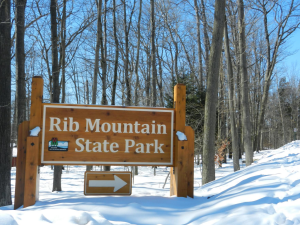
A sign at Rib Mountain State Park
Most of Rib Mountain is state-owned and is home to the 1,627-acre Rib Mount State Park. The peak, which has 24.5 km of hiking trails, is topped by a 60-meter-high observation tower, two observation decks facing north and south, and two exceptionally vast boulder formations called the Queen and King’s Chairs.
These sites are easily accessible by car via the 2.5-mile Park Road that circles the peak. The south side of the hill and some areas to the west consist of a networked trail system for hiking and snowshoeing, while the north side is dedicated exclusively to downhill skiing in winter.
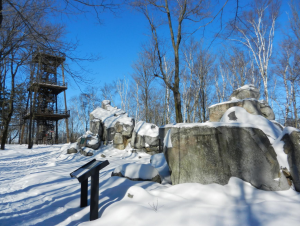

Quartzite boulders – queen and king chairs and a 60-meter observation tower on the top of Mount Rib
Granite Peak (named for the red granite found in Marathon County, where Rib Mountain is located) is the largest downhill ski area in Wisconsin with 75 trails, including three mogul trails, in 220 skiable acres. There is a 200-meter-high slope, 7 ski lifts, including 3 high-speed ones, and cozy cottages with restaurants, souvenirs and ski equipment rentals. Granite Peak is privately owned, but the hill is leased from the WI DNR.
Lots of snowshoe trails
In spring, trillium, hawkweed and mayberry beautify the landscape, and from time to time it can be found in the pulpit. Fall explodes with brilliant colors, and stands of maple, birch and trembling aspen make the forest ceiling look as if it were covered in gold, as if touched by King Midas. And in winter the hill is covered with white. The majestic branches of pine, spruce and eastern hemlock are covered with snow. The air is crisp and the landscape is exceptionally picturesque.
While the north side of the mountain is full of skiers, the south hill is uninhabited, still and picturesque. It is a slow-paced snowshoe. Hiking trails provide great snowshoeing opportunities through varied terrain where hikers will encounter changing forests, rock formations of varying sizes, and sloping slopes with gentle to steep climbs. Nine different trails are color-coded. Color codes can be found on the trail map available at the park entrance. Access the Rib Mountain State Park winter map online at http://dnr.wi.gov/topic/parks/name/ribmt/pdfs/ribmtnwinter.pdf.
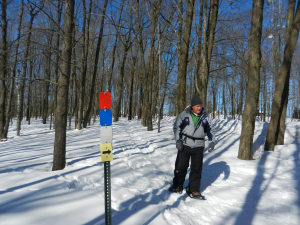

Rib Mountain trails are color-coded
Those who like to discover historical monuments should go snowshoeing along the blue, green and gray trails, starting from the summit, where they will find themselves among many mammoth boulders and the observation tower at the top (the tower is closed to climbers in winter). These trails lead up and down snow-covered rock steps installed in the 1930s by the Civil Conservation Corp. There are also stunning rock outcroppings offering spectacular views.
Adventure lovers should consider taking the Red Trail. It covers the area down and around, from the summit to the ranger station, winding through mixed northern hardwood and coniferous forest, with occasional views of the land below. Snowshoeing through varied terrain with some steep slopes, traversing just above impressive talus slopes formed by fallen pieces of quartzite boulders under the influence of gravity acting for thousands of years are just some of the challenges on the Red Trail.
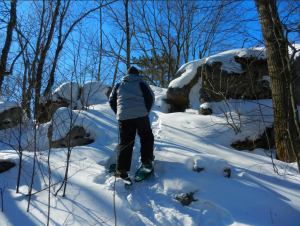

Snowshoeing up steep slopes and over vast boulders is typical of Rib Mountain
Long-distance runners with sturdy lungs and a good heart can cover this distance by taking the four-mile yellow trail. This trail runs along the southeast side of Mount Rib, parallel to the park road, and returns to the west, requiring a steep uphill hike. It is possible to complete one of the four laps of the yellow trail. Regardless of the circle chosen, the hiker will eventually head back west and climb back to Mount Rib. The entire yellow trail is definitely a workout. The newer trails on the western end of Mount Rib also offer spectacular hiking opportunities.
The Homestead Loop Trail is a loop of just over 1¼ miles that passes by the foundations of an elderly farmhouse dating back to the tardy 1800s and through a magnificent stand of hemlock trees. The Turkey Vulture Trail runs around an elderly quarry where turkey vultures roost on the quarry walls in the summer. After 1.5 miles, the trail connects to the Homestead Loop and leads back to the parking lot. The Dynamite Trail is only a quarter of a mile long and connects to the Turkey Vulture and Homestead Loop. Its name comes from the former location of a dynamite warehouse used during historical mining operations conducted by 3M.
Homestead Loop also connects to the Quarry Trail, a looped trail that can also be accessed from the Red Trail to the summit. The Quarry Trail leads to a former quartzite quarry. The only trail that is not open in winter is part of the Gray Trail, which runs on the north side of the hill. This section is closed during the downhill season due to the proximity of the ski slope.
Snowshoe parties in the mountains
Friends of Rib Mountain State Park sponsors two snowshoe events on the hill each year. A daytime snowshoe walk is planned on Saturday in early January, and a candlelight snowshoe walk on Saturday in mid-February. The upper trails are lit with candles, giving the impression that a thousand Tinkers have invaded Rib Mountain. The program will be followed by a bonfire and scorching chocolate… the perfect social event to encourage guests to go snowshoeing.
There is no cost to any event. However, if you are attending events or visiting on another day, you must purchase a daily park sticker. You can also get an annual sticker if you plan to return or visit other Wisconsin state parks. For information about park decals, go to the website http://dnr.wi.gov/topic/parks/admission.html. Information about Rib Mountain State Park can be found online at http://dnr.wi.gov/topic/parks/name/ribmt/ or call 715 842-2522.
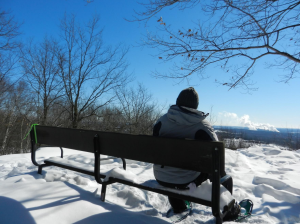

Sunrise Lookout… a place with a view
My favorite spot on Rib Mountain off the yellow and gray trail is Sunrise Lookout. I often sit on this rock and admire the southeastern view below with farmland, a nearby community, and an adjacent hill in sight. A few hundred yards beyond Cobbler’s Knob, I climb a steep boulder and then descend another rock formation that drops to the Sunrise Lookout. There is a bench there. Go ahead… you can apply it because there’s plenty of room for both of us.


